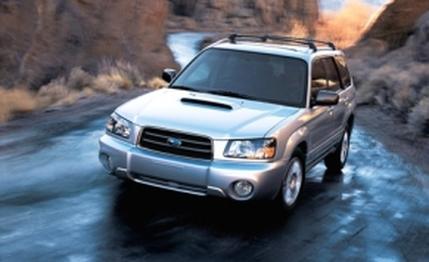
 Road Test
Road Test
In Silverthorn, Colorado, there is a place called the Eisenhower Tunnel, at 11,000 feet above sea level. It was the site two years ago of somber discussions between members of the Subaru Forester engine testing and development team and their boss, Kazuharu Ichikawa, the man who has been working on Subaru's famous boxer engines for close to 25 years.
At altitude, the Forester engine just didn't have enough suds. That's a real problem for a Subaru, because Subaru wagons have become standard issue in ski areas. If the Forester were going to succeed at altitude against new competitors, more suds would have to be found.
So they rigged up a test mule with the 2.0-liter turbo engine used in the Impreza WRX. Even with a turbo, it was the little engine that couldn't. It was decided the larger 2.5-liter engine from the Forester would get a turbo of its own, and the Forester 2.5XT was born.
But this is not the 300-hp, 300-pound-feet engine from the '04 WRX STi. That engine, with its big IHI turbocharger, wasn't what the doctor ordered for a family SUV. Nor was the 227-hp engine from the standard WRX.
What we have here is a custom-made 210-hp, 235-pound-feet DOHC 2.5-liter boxer four with variable intake-valve timing through 35 degrees of crankshaft rotation and its own smaller Mitsubishi Heavy Industries intercooled turbo, a unit that produces faster throttle response and spool-up than the IHI unit. Boost maxes out at 11.6 psi versus 14.5 psi for the STi engine, and that figure of 235 pound-feet at 3600 rpm is a whopping 42 percent more than the plain-vanilla engine generates.
There's a patented new trick to this engine, too. Ichikawa-san's engineers found that the aluminum rear main bearing cap was letting the crankshaft wobble a bit, opening up the bearing clearance over time and generating a rattling noise. So they invented a new kind of main bearing cap that has a shaped sintered-steel core and an aluminum wrapper that does the job with two conventional bolts. The 2.5-liter XT turbo engine also gets a new semi-closed-deck block, heavy-duty connecting rods, forged pistons, and a drive-by-wire throttle setup.
But no turbo model worthy of the name, the name in this case being Forester 2.5XT, to go along with the X and XS models already in the lineup, goes to market with the same look as its naturally aspirated siblings. It simply isn't done.
So the Subaru guys did a complete package for the turbocharged Forester. First, and most noticeable, is the functional air scoop in its aluminum alloy hood.
The turbo, the intercooler, and the scoop are joined by a set of tasty split-spoke, 16-inch alloy wheels and matching high-performance tires; a special combination of instruments, seats, fabrics, textures, and interior graphics; a seven-speaker, 120-watt sound system with a six-CD changer; a chromed exhaust tip; brushed aluminum roof rails; and 2.5XT badging-all in a package for which the company is asking $1825, bringing the price of a five-speed manual version to $25,520 (compared with $23,695 for the Forester XS five-speed). The Premium package-leather seating, a sunroof, and an automatic transaxle-will set you back another $2550.
For high-density commuting, you might consider the 2.5XT with a four-speed automatic, priced at $26,320. When you order the auto version, you get a different engine calibration as well as active all-wheel drive. The manual XT turbo varies its 50/50 front-to-rear power delivery through a viscous coupling depending on measured wheel slip, but the active version used with the automatic uses an electronic continuously variable transfer clutch, varying torque depending on whether the Forester is accelerating or decelerating.
Our test mount, a silver 2.5XT manual, was subjected to a few days of generalized abuse in Lake Placid, New York, before setting off on a 600-mile, one-day blitz back to the offices in Ann Arbor and then being passed around to the staff for two weeks. At no time during this period did anyone not smile a little when driving the XT.